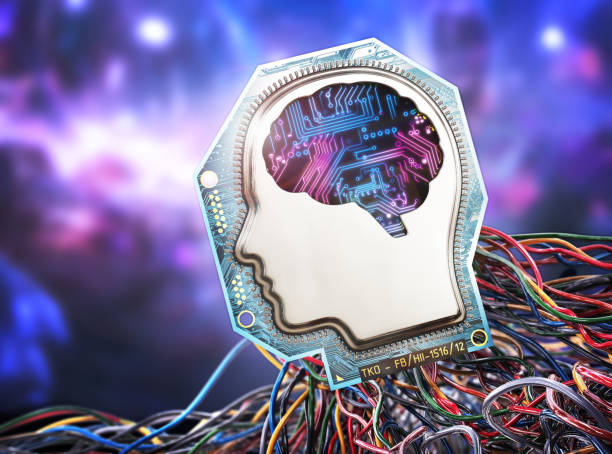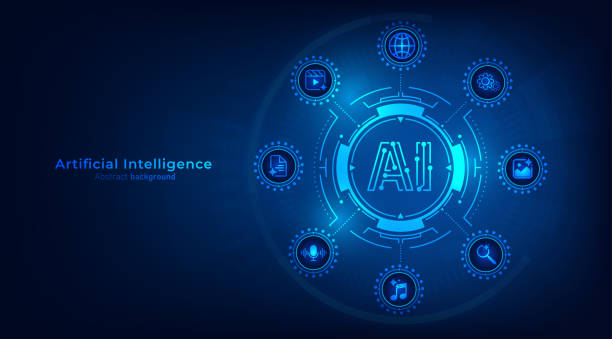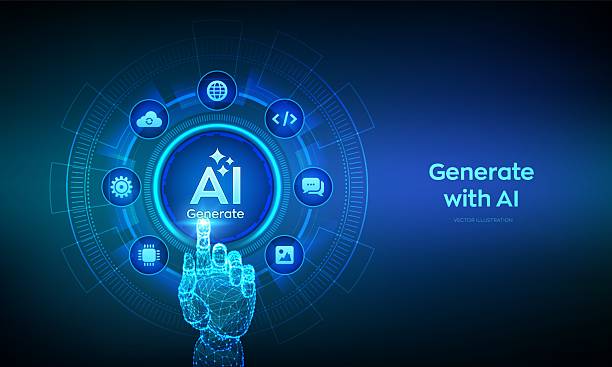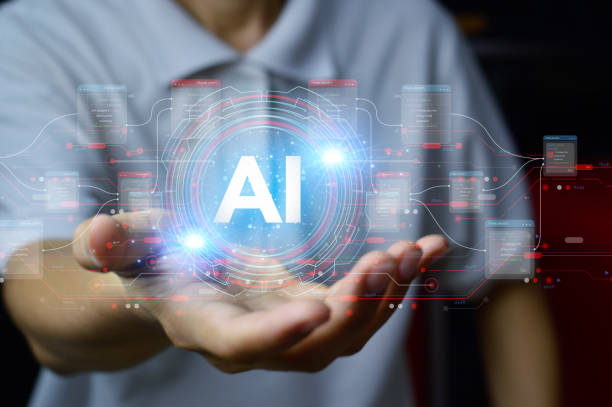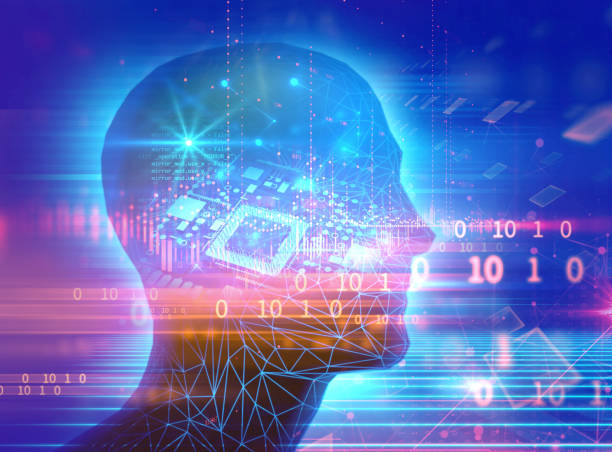What is Artificial Intelligence? Definition, History, and Basic Concepts
#Artificial_Intelligence (AI) is a branch of computer science that deals with building machines that can perform tasks that usually require human intelligence.
These tasks include learning, reasoning, problem-solving, perception, and natural language processing.
Artificial intelligence is a broad field that includes various sub-branches such as machine learning (ML), deep learning (DL), and Natural Language Processing (NLP).
The history of artificial intelligence dates back to the 1950s, when researchers began exploring the possibility of building machines that could think.
One of the first AI programs was the “Logic Theorist” program, created in 1956 by Allen Newell and Herbert Simon.
This program could prove mathematical theorems.
During the 1960s and 1970s, artificial intelligence faced challenges, but in the 1980s and 1990s, it regained attention with the advent of machine learning and increased computing power.
Today, artificial intelligence is used in many fields, including medicine, finance, transportation, and manufacturing.
Some basic concepts in artificial intelligence include:
- Algorithm: A set of instructions that a computer follows to perform a specific task.
- Data: Information that a computer uses to learn and make decisions.
- Model: A representation of a system or process that a computer can use to predict or make decisions.
- Neural Network: A computational model inspired by the structure of the human brain.
Tired of losing customers due to poor e-commerce site design? With Rasaweb, solve this problem forever!
✅ Increase sales and visitor-to-customer conversion rates
✅ Smooth and attractive user experience for your customers⚡ Get a free consultation
Applications of Artificial Intelligence in Today’s World
Artificial intelligence (AI) is currently used in a wide range of industries and applications.
These applications are expanding daily and have a significant impact on our lives.
Some of the most important applications of artificial intelligence include:
Click here to preview your posts with PRO themes ››
Healthcare: AI is used in diagnosing diseases, developing drugs, personalizing treatments, and improving patient care.
For example, AI algorithms can analyze medical images and detect disease patterns, or surgical robots can perform surgery with greater precision.
Finance: AI is used in fraud detection, risk management, providing financial advisory services, and automating banking processes.
AI algorithms can identify suspicious patterns in financial transactions and prevent fraud.
Transportation: AI is used in the development of self-driving cars, route optimization, and traffic management.
Self-driving cars can understand their surroundings using sensors and AI algorithms and move without the need for a human driver.
Manufacturing: AI is used in automating production lines, quality control, and optimizing production processes.
Industrial robots equipped with AI can perform repetitive and dangerous tasks with greater accuracy and speed.
Marketing and Sales: AI is used in personalizing advertising, analyzing customer behavior, and forecasting sales.
AI algorithms can display more targeted advertisements to customers by analyzing their data.
In addition to these, artificial intelligence has many applications in other fields such as education, security, energy, and agriculture.
This technology is rapidly advancing and is expected to play an even more important role in our lives in the future.
Machine Learning and Deep Learning: Concepts and Differences
Machine Learning and Deep Learning are two important sub-branches of artificial intelligence that allow machines to learn from data without explicit programming.
Machine learning includes algorithms that can identify patterns in data and use these patterns to make predictions or decisions.
While deep learning is a type of machine learning that uses artificial neural networks with multiple layers to analyze data.
Key Differences
- Structure: Machine learning uses a variety of algorithms, while deep learning relies specifically on deep neural networks.
- Data Processing: Machine learning typically requires structured data and specific features, while deep learning can directly process raw and unstructured data such as images and audio.
- Complexity: Deep learning usually requires more computing power and can solve more complex problems.
- Feature Extraction: In machine learning, feature extraction is usually done by humans, while in deep learning, neural networks extract relevant features from the data themselves.
Click here to preview your posts with PRO themes ››
For example, in image recognition, a machine learning algorithm may require a set of predetermined features such as edges, corners, and textures.
In contrast, a deep neural network can learn directly from image pixels which features are important for object recognition.
In short, deep learning is a more advanced type of machine learning that can work with more complex and unstructured data and deliver more accurate results.
However, deep learning requires more computing power and a larger volume of data.
| Feature | Machine Learning | Deep Learning |
|---|---|---|
| Structure | Variety of algorithms | Deep neural networks |
| Data Processing | Structured data | Unstructured data |
| Complexity | Less complex | More complex |
| Feature Extraction | Manual | Automatic |
How Does Natural Language Processing (NLP) Enable Machines to Understand Human Language?
Natural Language Processing (NLP) is a branch of artificial intelligence that enables machines to understand and process human language.
The main goal of NLP is to build systems that can communicate with humans in natural language, extract information from text, and generate new text.
NLP includes a set of techniques and algorithms that help machines understand various aspects of language, including:
- Syntactic Analysis: Understanding the grammatical structure of sentences.
- Semantic Analysis: Understanding the meaning of words and sentences.
- Discourse Analysis: Understanding the speaker’s intention in expressing a sentence.
NLP is used in a wide range of applications, including:
- Machine Translation: Translating text from one language to another.
- Chatbots: Answering user questions and providing support services.
- Text Summarization: Generating short summaries of long texts.
- Sentiment Analysis: Identifying the emotions present in the text.
- Speech Recognition: Converting speech to text.
For example, a machine translation system using NLP techniques can analyze the grammatical structure and meaning of words in a sentence in the source language and generate its equivalent in the target language.
Or a chatbot using NLP can understand user questions and provide appropriate answers.
Does your current website represent your brand’s credibility as it should? Or does it drive away potential customers?
Rasaweb, with years of experience in designing professional corporate websites, is your comprehensive solution.
✅ A modern, beautiful website that matches your brand identity
✅ Significant increase in lead generation and new customers
⚡ Contact Rasaweb now for a free corporate website design consultation!
Ethics in Artificial Intelligence: Challenges and Key Considerations
With its rapid advancement, artificial intelligence (AI) not only creates many opportunities but also poses significant ethical challenges.
These challenges include issues such as discrimination, privacy, accountability, and impact on employment.
Attention to these ethical considerations is essential for the responsible development and use of artificial intelligence.
Discrimination: AI algorithms can reinforce existing biases in training data, leading to unfair decisions.
For example, an AI-based hiring system may unintentionally reject applicants of a particular gender or race.
Privacy: AI systems often require large amounts of personal data, which can create serious privacy concerns.
The collection, storage, and use of this data must comply with privacy laws and regulations.
Accountability: If an AI system makes a mistake, it is difficult to determine responsibility.
Is the developer, manufacturer, or user responsible? Creating legal and ethical frameworks to determine responsibility in these cases is essential.
Impact on Employment: AI can automate many jobs and lead to job losses.
Programs should be created to retrain and support those affected by these changes.
In addition, issues such as algorithm transparency, explainability of AI decisions, and the potential for misuse of this technology are also important ethical considerations.
To address these challenges, cooperation between researchers, policymakers, and ethics experts is needed.
The Future of Artificial Intelligence: Predictions and Key Trends
The future of artificial intelligence (AI) is bright and full of potential.
With continuous advances in algorithms, hardware, and data volumes, artificial intelligence is changing the way we live and work.
It is predicted that in the future, artificial intelligence will play a more important role in various fields, including:
- Automation: Automating repetitive processes and difficult tasks in various industries.
- Healthcare: Improving the diagnosis and treatment of diseases, developing new drugs, and providing personalized care.
- Transportation: Expanding self-driving cars and improving the safety and efficiency of transportation systems.
- Education: Providing personalized education and easier access to educational resources.
- Environment: Helping to solve environmental problems such as climate change and pollution.
Some key trends we will see in the future of artificial intelligence include:
- Explainable AI (XAI): Efforts to build algorithms that can explain how they make decisions.
- Ethical AI: Greater attention to ethical issues and efforts to develop fair and responsible AI systems.
- Distributed AI: Using artificial intelligence in various devices and the Internet of Things networks.
- Generative AI: Developing algorithms that can generate new content such as text, images, and music.
However, the development and use of artificial intelligence require attention to potential challenges and risks as well.
It must be ensured that this technology is used for the benefit of all members of society and that its misuse is prevented.
Introduction to Artificial Intelligence Development Tools and Platforms
The development of #Artificial_Intelligence (AI) requires the use of various tools and platforms that allow researchers and developers to design, train, and implement algorithms.
Some of the most popular AI development tools and platforms include:
- TensorFlow: An open-source machine learning library developed by Google.
TensorFlow is suitable for developing a wide range of AI applications due to its flexibility and high scalability. - PyTorch: An open-source machine learning library developed by Facebook.
PyTorch is suitable for research and rapid development of machine learning algorithms due to its simplicity and ease of use. - Scikit-learn: A Python library for machine learning that includes various algorithms for classification, regression, clustering, and dimensionality reduction.
Scikit-learn is very suitable for getting started with machine learning due to its simplicity and good documentation. - Keras: A high-level API for building and training neural networks.
Keras can work with TensorFlow, PyTorch, and other machine learning libraries.
Keras is suitable for rapid development of deep learning models due to its simplicity and usability. - Cloud Platforms: Cloud platforms such as Amazon Web Services (AWS), Google Cloud Platform (GCP), and Microsoft Azure offer various tools for developing and deploying AI applications.
These platforms provide access to powerful hardware, data management services, and machine learning tools.
Choosing the right tools and platforms for AI development depends on the specific needs and goals of the project.
For research projects, PyTorch may be a better choice, while for commercial projects, TensorFlow or a cloud platform may be more suitable.
| Tool | Developer | Programming Language | Application |
|---|---|---|---|
| TensorFlow | Python, C++ | Machine Learning | |
| PyTorch | Python, C++ | Machine Learning | |
| Scikit-learn | Open Source | Python | Machine Learning |
| Keras | Open Source | Python | Neural Networks |
The Role of Data in the Success of Artificial Intelligence Projects
Data plays a vital role in the success of artificial intelligence (AI) projects.
AI algorithms need high-quality, high-volume data for learning and prediction.
The more data there is and the more diverse it is, the more accurate patterns the algorithm can identify and the better results it can provide.
Importance of Data
- Learning: AI algorithms learn from data and use this data to build prediction models.
- Accuracy: Data quality has a direct impact on the accuracy and efficiency of algorithms.
Incomplete, inaccurate, or biased data can lead to incorrect results. - Generalizability: Diverse data allows algorithms to identify general patterns and generalize well to new data.
Data Management Steps
- Collection: Collecting data from various sources, such as databases, files, APIs, and sensors.
- Cleaning: Cleaning data from errors, missing values, and anomalies.
- Transformation: Transforming data into a format suitable for machine learning algorithms.
- Labeling: Labeling data for training supervised learning algorithms.
- Storage: Storing data in a suitable database or storage system.
Proper data management is a complex process that requires careful planning and the use of appropriate tools.
To ensure the success of artificial intelligence projects, special attention should be paid to the quality, quantity, and diversity of data.
Don’t have a corporate website yet and are missing out on online opportunities? With professional corporate website design by Rasaweb,
✅ Double the credibility of your business
✅ Attract new customers
⚡ Free consultation for your corporate website!
Challenges of Implementing Artificial Intelligence in Organizations
Implementing artificial intelligence (AI) in organizations is associated with several challenges that can jeopardize the success of AI projects.
Some of the most important of these challenges include:
- Lack of Expertise: The lack of skilled experts in the field of artificial intelligence is one of the biggest challenges in implementing this technology.
Organizations must invest in attracting and training artificial intelligence specialists. - Data Quality: Poor data quality can lead to poor results and incorrect decisions.
Organizations must pay special attention to cleaning, transforming, and managing their data. - Cost: Implementing artificial intelligence can be expensive, especially if the organization needs to purchase new hardware and software.
- Resistance to Change: Some employees may resist changes resulting from artificial intelligence, especially if they feel that their job is at risk.
Organizations must strive to manage this resistance and create a culture of acceptance of change. - Ethical Issues: Artificial intelligence can create new ethical issues, such as discrimination and privacy.
Organizations must pay attention to these issues and ensure that artificial intelligence is used responsibly.
To overcome these challenges, organizations must have a comprehensive strategy for implementing artificial intelligence.
This strategy should include the following:
- Defining Goals: The organization must set specific goals for the use of artificial intelligence.
- Assessing Readiness: The organization must assess its readiness for implementing artificial intelligence.
- Selecting Projects: The organization must select artificial intelligence projects that create the most value for the organization.
- Creating a Team: The organization must create a specialized team to implement artificial intelligence projects.
- Change Management: The organization must plan for managing changes resulting from artificial intelligence.
More Learning Resources in the Field of Artificial Intelligence
To learn more about artificial intelligence (AI), various resources are available, including online courses, books, scientific articles, and conferences.
Choosing the right resource depends on your level of knowledge, interest, and learning goals.
Online Courses
- Coursera: Offers artificial intelligence courses from top universities in the world.
- edX: Offers artificial intelligence courses from top universities in the world.
- Udacity: Offers nanodegree courses in the field of artificial intelligence.
- Fast.ai: Offers practical deep learning courses.
Books
- “Artificial Intelligence: A Modern Approach” by Stuart Russell and Peter Norvig.
- “Deep Learning” by Ian Goodfellow, Yoshua Bengio, and Aaron Courville.
- “Machine Learning Algorithms” by Tom Mitchell.
Scientific Articles
- Journal of Artificial Intelligence Research (JAIR)
- IEEE Transactions on Pattern Analysis and Machine Intelligence (PAMI)
- Neural Information Processing Systems (NeurIPS)
- International Conference on Machine Learning (ICML)
Conferences
- Neural Information Processing Systems (NeurIPS)
- International Conference on Machine Learning (ICML)
- International Joint Conference on Artificial Intelligence (IJCAI)
- AAAI Conference on Artificial Intelligence (AAAI)
In addition to these resources, you can also use blogs, podcasts, and YouTube channels to learn about artificial intelligence.
The most important thing is to continue learning with motivation and perseverance and to take advantage of various opportunities to expand your knowledge.
Frequently Asked Questions
| Question | Answer |
|---|---|
| 1. What is Artificial Intelligence (AI)? | It is a branch of computer science that aims to create machines capable of simulating human intelligence and performing tasks that require human thinking, such as learning, problem-solving, and decision-making. |
| 2. What are the main types of Artificial Intelligence? | They can be classified into weak artificial intelligence (Narrow AI) that focuses on a specific task, general artificial intelligence (General AI) that possesses comprehensive human capabilities, and super artificial intelligence (Super AI) that exceeds human intelligence. |
| 3. Mention some common Artificial Intelligence applications in our daily lives. | These include voice assistants (such as Siri and Alexa), recommendation systems (such as Netflix and Amazon), self-driving cars, facial recognition systems, and spam filters. |
| 4. What is the difference between Artificial Intelligence and Machine Learning? | Artificial Intelligence is the broader concept of creating intelligent machines, while Machine Learning is a subset of Artificial Intelligence that focuses on enabling systems to learn from data without explicit programming. |
| 5. What is Deep Learning? | It is a subset of Machine Learning that uses multi-layered artificial neural networks (deep neural networks) to process data and discover complex patterns, and is used in image and speech recognition. |
| 6. What are the most prominent benefits of Artificial Intelligence? | Improving efficiency and productivity, automating repetitive tasks, making better decisions based on big data analysis, and developing solutions to complex problems in fields such as medicine and science. |
| 7. What are the main challenges facing the development and deployment of Artificial Intelligence? | These include the need for vast amounts of high-quality data, privacy and security issues, bias in data and algorithms, and high development and maintenance costs. |
| 8. Does Artificial Intelligence raise ethical or social concerns? | Yes, it raises concerns related to privacy, algorithmic bias, job losses due to automation, and responsibility for errors committed by intelligent systems, and the need for a regulatory framework. |
| 9. How can Artificial Intelligence affect the future of the labor market? | It can lead to the automation of some routine jobs, but it will also create new jobs that require advanced skills in developing, operating, and maintaining Artificial Intelligence systems. |
| 10. What are some modern or promising technologies in the field of Artificial Intelligence? | These include advanced Natural Language Processing (NLP) (such as large language models like ChatGPT), computer vision, robotics, and Generative AI. |
And other services of Rasa Web Advertising Agency in the field of advertising
Smart Conversion Rate Optimization: A new service to increase customer behavior analysis through a SEO-based content strategy.
Smart Marketing Automation: A creative platform to improve campaign management by optimizing key pages.
Smart SEO: A fast and efficient solution for digital branding with a focus on proprietary programming.
Smart Link Building: Professional optimization for online growth using Google Ads management.
Smart Custom Software: A new service to increase user interaction through a SEO-based content strategy.
And more than hundreds of other services in the field of internet advertising, advertising consulting and organizational solutions
Internet Advertising | Advertising Strategy | Advertorial Reports
Sources
What is Analytical AI?
,IBM Artificial Intelligence
,What is Artificial Intelligence? | Oracle
,Artificial Intelligence: The Ultimate Guide for Businesses in 2024
? Are you ready to transform your business in the digital world? With Rasaweb Afrin Digital Marketing Agency, from SEO strategies to professional WordPress website design, achieve the best results and build a bright future for your brand.
📍 Tehran, Mirdamad Street, next to the Central Bank, South Kazerun Alley, Ramin Alley No. 6
“`

